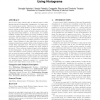128
Voted
CCR
2004
15 years 15 days ago
2004
There has been much interest in both unstructured and structured overlays recently. Unstructured overlays, like Gnutella, build a random graph and use flooding or random walks on ...
110
Voted
DAIS
2009
15 years 1 months ago
2009
Overlay networks have emerged as a powerful paradigm to realise a large range of distributed services. However, as the number of overlays grows and the systems that use them become...
EURONGI
2006
Springer
15 years 4 months ago
2006
Springer
Structured overlay networks is an important and interesting primitive that can be used by diverse peer-to-peer applications. Multiple overlays can result either because of network ...
105
click to vote
ICNP
2000
IEEE
15 years 5 months ago
2000
IEEE
The X-Bone dynamically deploys and manages Internet overlays to reduce con®guration eort and increase network component sharing. The X-Bone discovers, con®gures, and monitors ...
105
click to vote
ICNP
2003
IEEE
15 years 6 months ago
2003
IEEE
Structured peer-to-peer overlays provide a natural infrastructure for resilient routing via efficient fault detection and precomputation of backup paths. These overlays can respo...
112
click to vote
CIKM
2005
Springer
15 years 6 months ago
2005
Springer
Peer-to-peer (p2p) systems offer an efficient means of data sharing among a dynamically changing set of a large number of autonomous nodes. Each node in a p2p system is connected...
113
Voted
IPPS
2005
IEEE
15 years 6 months ago
2005
IEEE
Most of current peer-to-peer designs build their own system overlays independent of the physical one. Nodes within unstructured systems form a random overlay, on the contrary, str...
100
Voted
KIVS
2009
Springer
15 years 7 months ago
2009
Springer
New overlay-based services aim to provide properties like resilience, availability or QoS. To achieve this, automatic organization and optimization is required, which again demands...





